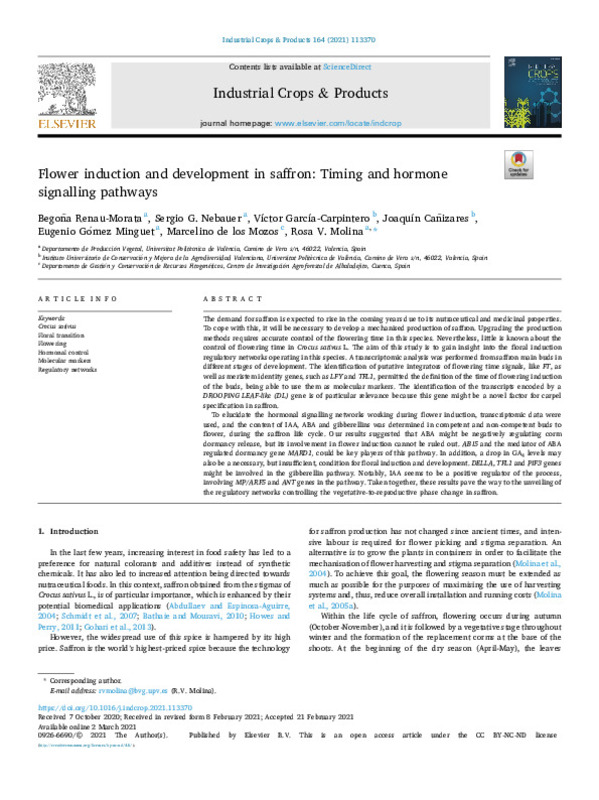JavaScript is disabled for your browser. Some features of this site may not work without it.
Buscar en RiuNet
Listar
Mi cuenta
Estadísticas
Ayuda RiuNet
Admin. UPV
Flower induction and development in saffron: Timing and hormone signalling pathways
Mostrar el registro sencillo del ítem
Ficheros en el ítem
| dc.contributor.author | Renau-Morata, Begoña
|
es_ES |
| dc.contributor.author | Nebauer, Sergio G.
|
es_ES |
| dc.contributor.author | García-Carpintero, Víctor
|
es_ES |
| dc.contributor.author | Cañizares Sales, Joaquín
|
es_ES |
| dc.contributor.author | Minguet, E.G.
|
es_ES |
| dc.contributor.author | De los Mozos, Marcelino
|
es_ES |
| dc.contributor.author | Molina Romero, Rosa Victoria
|
es_ES |
| dc.date.accessioned | 2022-09-26T18:02:49Z | |
| dc.date.available | 2022-09-26T18:02:49Z | |
| dc.date.issued | 2021-06 | es_ES |
| dc.identifier.issn | 0926-6690 | es_ES |
| dc.identifier.uri | http://hdl.handle.net/10251/186579 | |
| dc.description.abstract | [EN] The demand for saffron is expected to rise in the coming years due to its nutraceutical and medicinal properties. To cope with this, it will be necessary to develop a mechanised production of saffron. Upgrading the production methods requires accurate control of the flowering time in this species. Nevertheless, little is known about the control of flowering time in Crocus sativus L. The aim of this study is to gain insight into the floral induction regulatory networks operating in this species. A transcriptomic analysis was performed from saffron main buds in different stages of development. The identification of putative integrators of flowering time signals, like FT, as well as meristem identity genes, such as LFY and TFL1, permitted the definition of the time of flowering induction of the buds, being able to use them as molecular markers. The identification of the transcripts encoded by a DROOPING LEAF-like (DL) gene is of particular relevance because this gene might be a novel factor for carpel specification in saffron. To elucidate the hormonal signalling networks working during flower induction, transcriptomic data were used, and the content of IAA, ABA and gibberellins was determined in competent and non-competent buds to flower, during the saffron life cycle. Our results suggested that ABA might be negatively regulating corm dormancy release, but its involvement in flower induction cannot be ruled out. ABI5 and the mediator of ABA regulated dormancy gene MARD1, could be key players of this pathway. In addition, a drop in GA4 levels may also be a necessary, but insufficient, condition for floral induction and development. DELLA, TFL1 and PIF3 genes might be involved in the gibberellin pathway. Notably, IAA seems to be a positive regulator of the process, involving MP/ARF5 and ANT genes in the pathway. Taken together, these results pave the way to the unveiling of the regulatory networks controlling the vegetative-to-reproductive phase change in saffron. | es_ES |
| dc.description.sponsorship | The activities of this study have been supported by a project funded by the "Ministerio de Ciencia, Innovacion y Universidades de Espana" [AGL2016-77078-R]. | es_ES |
| dc.language | Inglés | es_ES |
| dc.publisher | Elsevier | es_ES |
| dc.relation.ispartof | Industrial Crops and Products | es_ES |
| dc.rights | Reconocimiento - No comercial - Sin obra derivada (by-nc-nd) | es_ES |
| dc.subject | Crocus sativus | es_ES |
| dc.subject | Floral transition | es_ES |
| dc.subject | Flowering | es_ES |
| dc.subject | Hormonal control | es_ES |
| dc.subject | Molecular markers | es_ES |
| dc.subject | Regulatory networks | es_ES |
| dc.subject.classification | GENETICA | es_ES |
| dc.subject.classification | FISIOLOGIA VEGETAL | es_ES |
| dc.title | Flower induction and development in saffron: Timing and hormone signalling pathways | es_ES |
| dc.type | Artículo | es_ES |
| dc.identifier.doi | 10.1016/j.indcrop.2021.113370 | es_ES |
| dc.relation.projectID | info:eu-repo/grantAgreement/AEI//AGL2016-77078-R//CONTROL DE LA FLORACION Y OPTIMIZACION DE LA NUTRICION PARA LA PRODUCCION DE AZAFRAN EN CULTIVO FORZADO EN INVERNADERO/ | es_ES |
| dc.rights.accessRights | Abierto | es_ES |
| dc.contributor.affiliation | Universitat Politècnica de València. Departamento de Biotecnología - Departament de Biotecnologia | es_ES |
| dc.contributor.affiliation | Universitat Politècnica de València. Instituto Universitario Mixto de Biología Molecular y Celular de Plantas - Institut Universitari Mixt de Biologia Molecular i Cel·lular de Plantes | es_ES |
| dc.contributor.affiliation | Universitat Politècnica de València. Departamento de Producción Vegetal - Departament de Producció Vegetal | es_ES |
| dc.description.bibliographicCitation | Renau-Morata, B.; Nebauer, SG.; García-Carpintero, V.; Cañizares Sales, J.; Minguet, E.; De Los Mozos, M.; Molina Romero, RV. (2021). Flower induction and development in saffron: Timing and hormone signalling pathways. Industrial Crops and Products. 164:1-19. https://doi.org/10.1016/j.indcrop.2021.113370 | es_ES |
| dc.description.accrualMethod | S | es_ES |
| dc.relation.publisherversion | https://doi.org/10.1016/j.indcrop.2021.113370 | es_ES |
| dc.description.upvformatpinicio | 1 | es_ES |
| dc.description.upvformatpfin | 19 | es_ES |
| dc.type.version | info:eu-repo/semantics/publishedVersion | es_ES |
| dc.description.volume | 164 | es_ES |
| dc.relation.pasarela | S\430495 | es_ES |
| dc.contributor.funder | Universitat Politècnica de València | es_ES |
| dc.subject.ods | 02.- Poner fin al hambre, conseguir la seguridad alimentaria y una mejor nutrición, y promover la agricultura sostenible | es_ES |
| upv.costeAPC | 3775,2 | es_ES |








